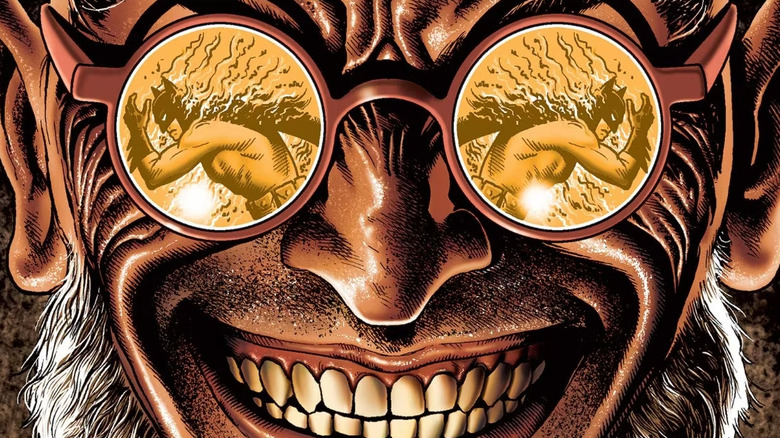Resurrection Brings A Classic DC Comics Villain Into Tim Burton’s Batman Universe
We may receive a commission on purchases made from links.
There will be spoilers for “Batman: Resurrection” in this article.
One of the great tragedies of the Michael Keaton and Tim Burton collaboration on “Batman” was that it didn’t last long enough. We only saw a few of the great villains and characters from the Batman rogues’ gallery represented, with some hints of what might have come if the franchise continued under Burton’s eye. We were robbed of a great Billy Dee Williams performance as Two-Face, which would have been legendary as his take on Harvey Dent was grounded and fascinating (though he would end up reprising the role in “The LEGO Batman Movie”).
Tim Burton’s take on the Penguin — played by Danny DeVito — was so far outside of what we might have expected that it was a revelation. Michelle Pfeiffer as Catwoman was legendary, and Jack Nicholson’s Joker set the bar so high that it has, arguably, never been surpassed for the character (at least in my subjective view).
I’d always imagined what other villains would have looked like grounded in the Art Deco-Gothic contemporary pseudo-1940s of Tim Burton’s Gotham City. I wanted to see what the Riddler would be like with that noir vibe or Poison Ivy with that Art Noveau bent. Imagine how a more hard-boiled killer of a criminal like Mr. Zsasz might fit in. Think of how Tim Burton might take on someone more absurd like the Mad Hatter. Surely, he couldn’t do worse than his take on the Mad Hatter in his abysmal “Alice in Wonderland” adaptation.
Thanks to John Jackson Miller’s new novel “Batman: Resurrection,” we get to see two classic Batman villains fit perfectly into Tim Burton’s world, and we even get teased with a third.
Clayface comes to Gotham City in Batman: Resurrection
The major villain of “Batman: Resurrection” is Clayface. For those unfamiliar with Clayface, he’s traditionally been a thief or an actor, depending on the version of the character. In fact, since his introduction in the comics in 1940, he’s had several different iterations. John Jackson Miller takes this and utilizes the fact that there’s no definitive version of the character to his advantage, and he gives us a new iteration in a down on his luck theatre actor named Karlo Babic.
Babic isn’t a handsome actor, and he struggles as an understudy, but he’s excellent at his craft and dedicated. When the diva of an actor he’s working for needs stage make up in the middle of Joker’s Smylex epidemic, Karlo is sent to the black market to fetch some, and then he has to serve as a guinea pig to make sure it’s safe. Instead of a great big smile and cardiac arrest like the other Smylex victims, something else happens to Karlo. Something monstrous.
He wakes up in the hospital and finds out, slowly, over the course of testing some strange new abilities, that he is able to mold himself to perfectly imitate others. Working at it and practicing, he eventually becomes Clayface, a name the newspapers give him.
Thanks to these powers of disguise, he’s able to make things a lot worse in Gotham, running Batman into the ground by forcing him to chase ghosts and grapple with trauma of things he’d thought had long since been buried. But Karlo has demons of his own he has to deal with, and Miller is able to create a fascinating three-dimensional character out of him who fits neatly into the Burton Bat-verse in a way I would have never imagined possible, right down to the theater palace of a hideout.
There’s another villain in Batman: Resurrection
“Batman: Resurrection” also features another villain in the book pulling some strings, and I’m loathe to reveal his identity, but it was not one I was expecting to see in the Tim Burton Bat-verse at all, let alone fit so seamlessly in this book. I won’t say where he comes in or where he comes about, but you will see how Hugo Strange enters into the story.
For longtime Batman fans, it won’t be much of a surprise, but again, John Jackson Miller weaves this supervillain — who originally appeared in an issue of “Detective Comics” in 1940 — into the story seamlessly through layers of identity and manipulation and brilliant schemes and plans. He is a perfect match for Michael Keaton’s Batman in the department of intellect and provides a challenge for him that is decidedly different than Jack Nicholson’s Joker and Danny DeVito’s Penguin. It gives us at once something new and unexpected.
The arrival of Hugo Strange a deep pull that fans of Batman comics will be happy with, and even if fans of the Burton films are unfamiliar with him, his work as a mastermind villain will work anyway in the context of the story and create a satisfying yarn for them.
But there’s another villain still waiting in the wings for the sequel to “Batman: Resurrection.” There are rumblings of a follow-up coming soon, and details in “Resurrection” seem to hint at righting at least one of the wrongs that the Joel Schumacher films did to the Burton Bat-verse. With how good this book was at marrying my literary taste to the Burton films, I can’t even wait.
“Batman: Resurrection” by John Jackson Miller is available now.

















Post Comment